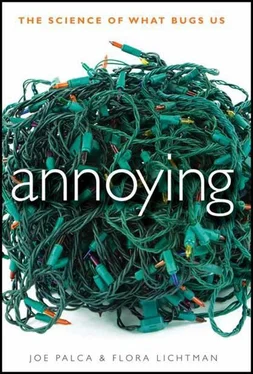Step two: Find people to listen to these sounds (“They weren’t coerced,” Blake insists) and have them rank the sounds according to their annoyingness. A session took about twenty to thirty minutes. Then the participants were asked to rate the sounds somewhere on a scale between pleasant and unpleasant.
Chimes were the most popular sound, but this isn’t exactly a ringing endorsement, given the competition. On the other end of the spectrum, the participants were highly unenthusiastic about the sounds of scraping wood and Styrofoam rubbing. The champion of the unpleasant category, however, was the fingernails-on-chalkboard sound of the garden tool running across slate.
The full ranking of sounds from pleasant to unpleasant is as follows:
1.Chimes
2.Rotating bicycle tire
3.Running water
4.Jingling keys
5.Pure tone
6.Pencil sharpener
7.Shaking metal parts
8.White noise
9.Compressed air
10.Blender motor
11.Dragged stool
12.Metal drawer being opened
13.Scraping wood
14.Scraping metal
15.Rubbing two pieces of Styrofoam together
16.Scraping slate [with a garden tool]
Step three: Analyze the acoustic properties of the fingernail scrape to look for acoustic signatures that could explain the essence of its annoyingness.
Sound is simply a change in pressure over time. The bigger the change in pressure, the louder the sound. When the metal prongs of the garden tool are dragged across a piece of slate, the friction between the two surfaces causes vibrations. These vibrations are changes in pressure. The frequency of a sound corresponds to how many pressure changes occur during the course of a second. The higher the frequency, the more pressure oscillations per second; the lower, the fewer. We hear higher frequencies as higher pitches.
A sound, however, is more than the sum of its vibrations. Blake says that if you just mix the frequency components randomly, you get noise—like the hissing of a radio between signals. All of the frequencies that are present in the fingernails-on-a-chalkboard sound might be present in static, Blake says, but they aren’t arranged in the same way. What gives a creak, a squawk, or a squeal its signature is how the peaks and troughs of the component sound waves appear in relation to one another over time.
Think of it like cooking: the proportions of the ingredients and when they’re added can mean the difference between marinara sauce and a Bloody Mary. The same is metaphorically true for sounds, with the frequencies as the ingredients.
The question Blake was trying to get at was: What frequencies were poisoning the pot? Signal processing helps answer this question by providing the recipe for the sound, revealing the mixture of component frequencies and at what levels they are added.
To try to understand which frequencies were the offending ones, the researchers tried removing ingredients. They wondered, At what point when we remove certain frequencies does the sound lose its aversive quality?
Blake hypothesized that the high frequencies were the root of the problem. Think about how you might describe the fingernail-scraping sound. The adjectives that come to mind are shrill , piercing , sharp . They’re pejorative, and they suggest that the offensive parts are the high pitches. “Intuition told us that if we removed the really high frequencies, that would de-fang the noise,” Blake says.
The researchers were wrong. Blake filtered out the high pitches and—weirdly—the sound was still really annoying. The sound was different: it was more muffled but not more pleasant, according to the study subjects.
It turned out that the sound got less annoying to the listeners only when the middle-range frequencies were taken out. The annoying frequencies were the mundane 500 to 2,000 Hz (Hz, or hertz, is the scientific unit for frequency, or in this case, pressure variations per second). These frequencies are right in the middle of our hearing range: humans can hear frequencies from about 20 Hz to 20,000 Hz—and that upper limit drops as our ears age. {13} 13 2. Dogs can hear pitches up to 40,000 Hz; chinchillas have a hearing range like ours; mice ears register sound up to 91,000 Hz (but they have trouble with frequencies under 1,000 Hz); catfish are limited to frequencies under 4,000 Hz.
All ears basically work the same way: think of them as funnels. Sound waves (pressure oscillations) travel through the air, shoot down the ear canal, and get absorbed by the eardrum, a membrane gate at the end of the ear canal. The vibrations travel through tiny bones that connect the eardrum to the cochlea—a hollow tube that is sort of like a snail shell. “If you were to unravel the snail, it’s essentially this long tube that’s divided by a membrane,” says Josh McDermott, a neuroscientist at New York University. “Different parts of the tube are sensitive to different frequencies. The part closest to the eardrum is sensitive to high frequencies and the part that’s farthest away is sensitive to low frequencies.”
So far, everything is mechanical: pressure oscillations are jiggling a membrane in your ear. Enter hair cells. The membrane is coated with them. These receptors get their name because they have little organelles that stick out from the cell wall like cowlicks. They’re called stereocilia and they’re small—about 5 microns long, one-twentieth the width of a human hair. Small but important: the stereocilia are responsible for detecting the jiggling. The hair cells do the remarkable task of translating those physical signals into electrical pulses that are sent to the brain. After the hair cells translate the pressure oscillations into electrical signals, the signals are transmitted to subcortical regions in the mid-brain, and then they make their way to the thalamus and the cortex, “and then a lot of stuff happens that we don’t understand,” McDermott says.
Not all sounds are heard equally: the human ear seems to have preferences for certain frequencies. The frequencies that contribute most to the annoyingness of the scraping sound are on the low end of the frequency range that our ear is most sensitive to. Humans can detect frequencies between 2,000 Hz and 5,000 Hz at lower volumes than other sounds. Around 3,000 Hz also happens to be the natural resonant frequency of the ear canal, studies show. This means that when a 3,000-Hz signal goes into the ear, it’s naturally amplified, due to the shape of the ear canal. {14} 14 3. B. Kruger, “An Update on the External Ear Resonance in Infants and Young Children,” Ear and Hearing 8(6) (1987): 333–336.
“It means that you can hear a sound at 3,000 Hz that has much less than a quarter of the energy of a sound at, say, 1,000 Hz,” says David Huron. “Here’s what’s fun. We record a bunch of different sounds made by humans, and we find out which sound has the most amount of energy right around 3,000 Hz that humans make. The answer is a scream. This is true of males, females, and children. When men scream, they break into a falsetto. They end up producing the max amount of energy in the same region as women and children when they scream. What this means is that the sound that we can detect at the greatest distance is the human scream. We’re most sensitive to a human scream.” Sounds in this frequency range will “distract you from any other task you’re involved in,” says Huron. This may explain why the fingernail noise got less annoying when the middle frequencies were removed—when the energies we’re most sensitive to are removed from the noise, it’s easier to tune out.
Читать дальше












